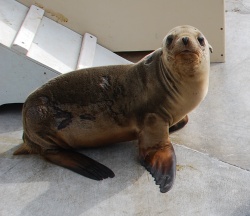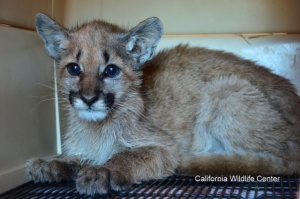They have loose, rolling skin and their ribs show through their tiny brown bodies. There is a glaze in their large round eyes. When they flop or lay down on the cement dry areas, it’s not the normal lounging that healthy California sea lions typically do for hours on end. Even their whiskers seem droopy. These pups are sick.
What’s more is there are a record number of sick pups this year. The biggest number in 20 years. Officials at the Marine Mammal Care Center in San Pedro say that the number of emaciated and dehydrated young sea lions is at the highest it’s recorded for 20 years for this time of year. Usually in January, the center receives maybe 11 or so strandings but so far, the center has admitted more than 60…and counting. (UPDATE: As of Feb. 11, 2013 the center has received more than 100 pups.)
 The Marine Mammal Care Center has never seen this many sick Cal seal lions at this time of year. (photo: Brenda Rees)
The Marine Mammal Care Center has never seen this many sick Cal seal lions at this time of year. (photo: Brenda Rees)
The staff, including an extensive volunteer organization, has been working overtime to care for and fatten up these normally active pinnipeds so they can return to the ocean. But the center’s enclosures are getting full and every day it seems, another thin and confused sea lion is brought in.
“We estimate that most of these pups are about 8 months old,” says David Bard, director of operations. “We really aren’t sure why we are seeing so many now. Usually January is a relatively quiet time for us. This has taken us all by surprise.”
Indeed, officials gave the go-ahead to start an extensive revamping of the center’s drainage system last month considering January is “downtime.” That’s all been put on hold since staff and volunteers are working round the clock to assess, treat and care for the skinny pups.
There are many theories as to what is causing so many malnourished young sea lions, but overall, scientists are stumped.
“We currently do not know the reasons for the poor condition of California sea lion pups,” says Sharon Melin, research biologist for NOAA currently based in Seattle, WA.
It could be a few factors or a combination. “Starving pups at this time of year usually means that the mothers are having trouble finding enough food to support the energetic cost of lactation,” says Melin. “It could also mean that mothers are dying from disease…but we do not have evidence that suggests this is occurring.”
Melin and fellow scientists are currently sampling dead and live pups to see if there are anything unusual that would explain low weights and the poor condition of the pups.
Another factor maybe the warmer-than-normal sea surface temperature that took place in Southern California in the fall of 2012. Warm temps could have relocated sea lion prey so mama sea lions were struggling to find food and produce milk. “At this time of year (February), most pups are not weaned completely and are still largely dependent on their mothers for nutrition,” she says.
Back at the noisy and bustling care center, healthier pups (ones who have been at the center the longest) are frolicking in a pool, barking and snapping at one another in true sea lion form. Others are draped protectively over their buddies as they sprawl on the sidelines. This wildly active scene is a sharp contrast to the nearby weak pups that still look, for lack of a better word, shell-shocked.
“[The sick pups]seem to be responding to the food and the medication,” says Dr. Lauren Palmer, on-staff vet, who along with Bard and the volunteers are hopeful they can weather the storm of sick pups. “So far, we have lost very few of them. That is encouraging.”
Indeed, Bard explains that the mandate of the Marine Mammal Care Center is to accept any sick or injured marine mammal found in the boundaries of Los Angeles County. “We are prepping in the back of our heads for the ‘worst case scenario’ if this condition still persists,” he says. “We’re taking it day by day.”
As a non-profit, the Marine Mammal Care Center relies on public donations for financial support. They also have a wish list of items that can be dropped off for use at the facility. Household bleach, safflower oil with vitamin E, bottled water and other items listed here are greatly appreciated.
The center is also opened for tours and school visits. Call to schedule a tour or to get more information.









